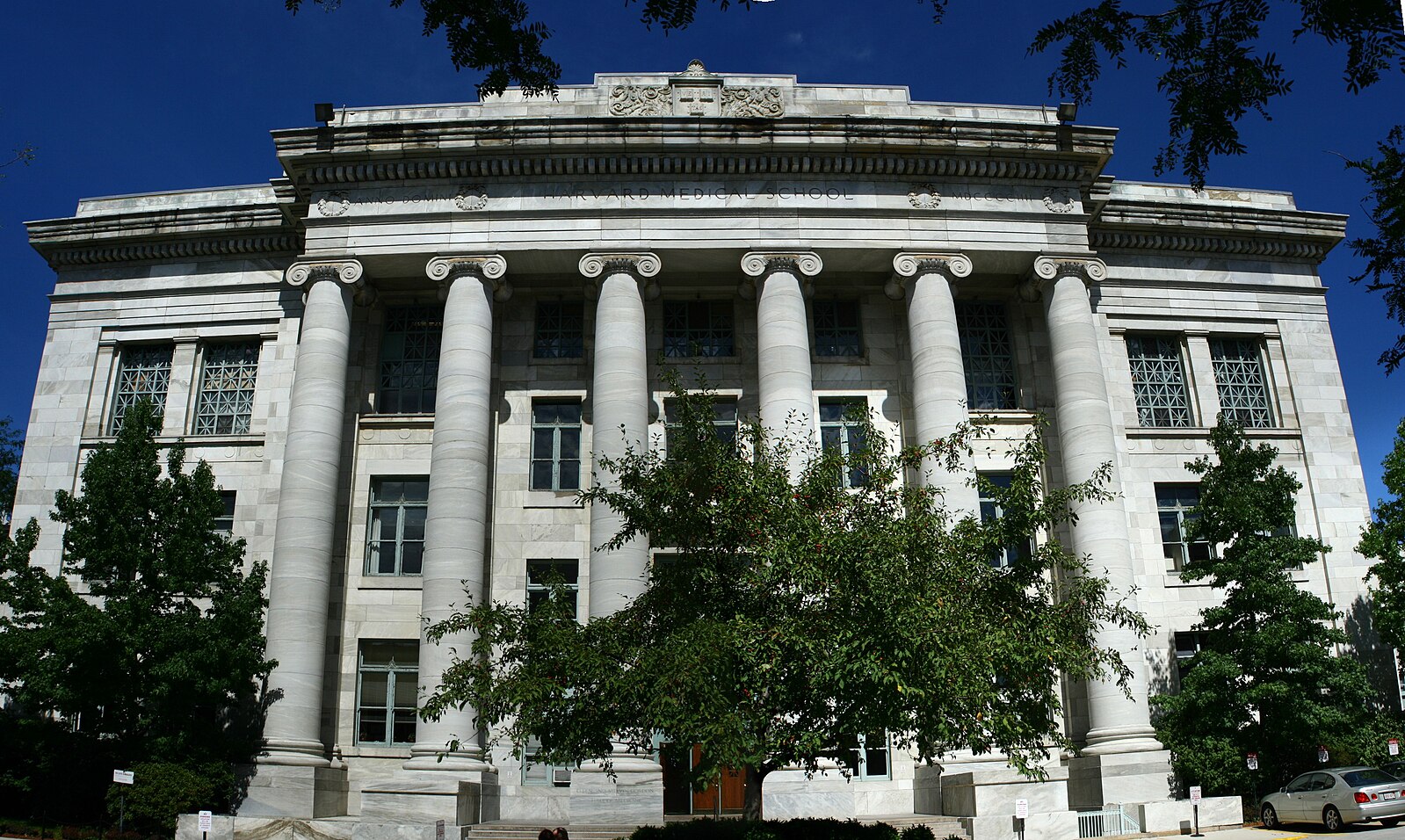Supreme Court strikes down affirmative action in college admissions

View of Harvard Medical School administrative building in Longwood medical area in Boston on September 5, 2007. WIKIMEDIA COMMONS/Thomas Steiner
July 3 (ZFJ) — Affirmative action in college admissions violates the Equal Protection Clause of the Fourteenth Amendment, ruled the Supreme Court in Students for Fair Admissions v. Harvard (20-1199) and SFFA v. University of North Carolina (21-707) on Thursday, June 29. The EPC prohibits racial discrimination by the government.
Reversing the lower courts’ decisions, the Court struck down the admissions programs used by Harvard and UNC by a 6-2 and 6-3 vote, respectively. Justice Ketanji Brown Jackson recused herself from the Harvard case because of her prior role on a Harvard governing body, the Board of Overseers.
BACKGROUND
The Court first upheld affirmative action in Regents of the University of California v. Bakke (76-811) without any single majority opinion. Establishing the precedent, Justice Lewis F. Powell Jr. wrote that racial quotas violate the EPC but race was still permissible as one of several admissions criteria.
The Court upheld affirmative action again in Grutter v. Bollinger (02-241), where it found that diversity in the student body is constitutionally permissible but requires use of a holistic system instead of specific quotas. The Court also said that race cannot be used as a “negative” against an applicant.
Harvard’s admissions system considers multiple categories: academic, extracurricular, athletic, school support, personal, and overall. Harvard says it considers race in the overall category to prevent a “dramatic drop-off” in minority students admitted compared to the previous class. The final stage of the process, called the “lop,” considers race, along with legacy status, recruited athlete status, and financial aid eligibility in deciding which tentatively-admitted students make the final cut.
The first stage of UNC’s process has readers look over each application. Readers are required to consider race as a factor and can give a “plus” depending on the applicant’s race in their provisionally-final written recommendations.
SFFA, a group founded by anti-affirmative action activist Edward Blum, brought the lawsuits against both colleges. Both district courts, in bench trials, found the admissions programs permissible. The 1st Circuit Court of Appeals affirmed for Harvard, and the Supreme Court granted review to UNC before the appeals court reached a judgment. Both cases were joined to jointly consider private and public colleges.
AGAINST AFFIRMATIVE ACTION
Chief Justice John Roberts delivered the opinion of the Court, joined by Justices Clarence Thomas, Samuel Alito, Neil Gorsuch, Brett Kavanaugh, and Amy Coney Barrett.
While the colleges argue affirmative action improves education through diversity (such as “training leaders” or “promoting the robust exchange of ideas”), Roberts wrote that “the interests they view as compelling cannot be subjected to meaningful judicial review.”
Roberts also found that the “admissions programs fail to articulate a meaningful connection between the means they employ and the goals they pursue.” He criticized racial categories as “imprecise,” such as for not distinguishing between South Asian or East Asian students and providing a classification for applicants from Middle Eastern countries.
Furthermore, the majority found that the colleges did use race as a “negative,” pointing to statistics that say that consideration of race has resulted in a decrease in Asian Americans admitted. Roberts additionally noted that the colleges “maintain that the demographics of their admitted classes would meaningfully change if race-based admissions were abandoned.”
“College admissions are zero-sum,” Roberts wrote. “A benefit provided to some applicants but not to others necessarily advantages the former group at the expense of the latter.”
However, the decision still allows applicants to discuss how their race has affected their specific experiences.
“Nothing in this opinion should be construed as prohibiting universities from considering an applicant’s discussion of how race affected his or her life, be it through discrimination, inspiration, or otherwise,” Roberts said. “A benefit to a student who overcame racial discrimination, for example, must be tied to that student’s courage and determination. Or a benefit to a student whose heritage or culture motivated him or her to assume a leadership role or attain a particular goal must be tied to that student’s unique ability to contribute to the university.”
“In other words,” he summarized, “the student must be treated based on his or her experiences as an individual—not on the basis of race.”
In a footnote, Roberts did not address whether or not the ruling applies to the U.S. military academies due to their “potentially distinct interests.”
Thomas delivered a concurring opinion to defend the colorblind interpretation of the Constitution and discuss harmful effects of affirmative action, referring to his opinion in Grutter.
To refute Justice Sonia Sotomayor’s principal dissent, he argued that the Court’s historical interpretation of the Constitution and post-Civil War federal laws supports a colorblind view.
He then said that such admissions policies “redistribute” blacks and Hispanics into more competitive colleges than “they would have otherwise attended,” placing them into more competitive environments that they are “less academically prepared” for. He further described a resulting “badge of inferiority” because “no one can distinguish those students from the ones whose race played a role in their admission.”
“It is an open question whether their skin color played a part in their advancement,” Thomas wrote.
He also added that “members of the same race do not all share the exact same experiences and viewpoints” and criticized the use of race to infer details such as socioeconomic status or medical conditions.
Gorsuch delivered a concurring opinion, joined by Thomas, to argue that the colleges’ admissions programs are also prohibited by Title VI of the Civil Rights Act of 1964.
Kavanaugh delivered a concurring opinion to argue that the majority’s ruling is consistent with the Court’s precedents in equal protection and affirmative action.
FOR AFFIRMATIVE ACTION
Justice Sonia Sotomayor delivered the principal dissent, joined by Justices Elena Kagan and Jackson (per UNC).
“The Court cements a superficial rule of colorblindness as a constitutional principle in an endemically segregated society where race has always mattered and continues to matter,” Sotomayor wrote.
To establish a need for affirmative action, she pointed to “systemic inequities.” For example, she noted, minorities are “more likely to live in poverty” and “[attend] schools with fewer resources” while “less likely to have parents with a postsecondary education who may be familiar with the college application process” or “attend preschool and other early childhood education programs.” The admissions programs in question, she said, take this “reality” into account.
Sotomayor decided that the lower courts ruled correctly that the admissions programs were “narrowly tailored” in their use of race. She said that Harvard “‘carefully considered’ other race-neutral ways to achieve its diversity goals, but none of them are ‘workable.’” Furthermore, she pointed to the many factors Harvard considered as evidence of race as a sole factor in a “holistic review” of applications and Harvard’s statistical evidence that “the admitted classes across racial groups varied considerably year to year.”
She criticized the majority for using misleading statistical evidence—noting that the 1st Circuit did not find specific discrimination against Asian Americans—and also for “an unrestrained disregard for precedent.”
She questioned the majority permitting students to still discuss race in their application essays, calling it “an attempt to put lipstick on a pig.”
“It is not a stereotype to acknowledge the basic truth that young people’s experiences are shaded by a societal structure where race matters,” Sotomayor wrote. “Nor is it a stereotype to acknowledge that race imposes certain burdens on students of color that it does not impose on white students.”
In response to Thomas’s concurring opinion, she cast doubt on the validity of the evidence supporting the “mismatch hypothesis” and disagreed with his claims of a “badge of inferiority.”
“The devastating impact of this decision cannot be overstated,” Sotomayor concluded.
Jackson delivered a dissenting opinion (per UNC), joined by Sotomayor and Kagan, to discuss “the universal benefits of considering race,” pointing to presently “existing gaps” related to race “first developed centuries ago.”
“To say that anyone is now victimized if a college considers whether that legacy of discrimination has unequally advantaged its applicants fails to acknowledge the well-documented intergenerational transmission of inequality that still plagues our citizenry,” Jackson wrote.
IMPLICATIONS
SFFA president Edward Blum celebrated the decision as a win for merit-based college admissions.
“The opinion issued today by the United States Supreme Court marks the beginning of the restoration of the colorblind legal covenant that binds together our multi-racial, multi-ethnic nation,” he said in a press release.
Harvard and UNC both stated that they would comply with the Court’s decision and are consulting legal experts on how to proceed.
“Harvard will continue to be a vibrant community whose members come from all walks of life, all over the world,” said Harvard University leadership in a letter.
“Carolina is committed to bringing together talented students with different perspectives and life experiences and to making an affordable, high-quality education accessible to the people of North Carolina and beyond,” said UNC Chancellor Kevin M. Guskiewicz in a campus email.
“I know today’s Court decision is a severe disappointment to so many people, including me, but we cannot let the decision be a permanent setback for the country,” said U.S. President Joe Biden as he announced the federal response to the decision. As part of it, within a month and a half, the Departments of Education and Justice will provide guidance to colleges on how to comply.
“This is not a normal Court,” he said in response to a question.
Common App, an undergraduate college admission application valid at over 1,000 institutions, announced changes to its platform for its member colleges.
“Beginning on August 1, Common App members will have the ability to hide the self-disclosed race and ethnicity information from application PDF files for both first-year and transfer applications, and to configure the data imports to recognize or exclude race and ethnicity,” the application platform said on Twitter.
The decision has upended longstanding admissions processes, forcing colleges to undertake revamps to comply with the Court’s ruling.
Many colleges have already been preparing alternative measures to achieve diversity in anticipation of the decision, but they say such programs are not as effective and will result in fewer minority admissions.
Critics have renewed their attacks on legacy admissions, asserting that they can no longer exist without affirmative action as a counterbalance.
References
- U.S. Supreme Court - 20-1199 Students for Fair Admissions, Inc. v. President and Fellows of Harvard College (06/29/2023) (Slip Opinion) - https://www.supremecourt.gov/opinions/22pdf/20-1199_hgdj.pdf
- Students for Fair Admissions - Students for Fair Admissions Applauds Supreme Court’s Decision to End Racial Preferences in College Admissions - https://www.prnewswire.com/news-releases/students-for-fair-admissions-applauds-supreme-courts-decision-to-end-racial-preferences-in-college-admissions-301867088.html (ARCHIVE)
- Harvard University - Supreme Court Decision - https://www.harvard.edu/admissionscase/2023/06/29/supreme-court-decision/ (ARCHIVE)
- University of North Carolina - A MESSAGE FROM THE CHANCELLOR: SUPREME COURT DECISION - https://admissionslawsuit.unc.edu/a-message-from-the-chancellor-supreme-court-decision/ (ARCHIVE)
- Common App - A statement from Common App’s President & CEO, Jenny Rickard - https://twitter.com/CommonApp/status/1674541612985188356
- White House - Remarks by President Biden on the Supreme Court’s Decision on Affirmative Action - https://www.whitehouse.gov/briefing-room/speeches-remarks/2023/06/29/remarks-by-president-biden-on-the-supreme-courts-decision-on-affirmative-action/ (ARCHIVE)
- White House - FACT SHEET: President Biden Announces Actions to Promote Educational Opportunity and Diversity in Colleges and Universities - https://www.whitehouse.gov/briefing-room/statements-releases/2023/06/29/fact-sheet-president-biden-announces-actions-to-promote-educational-opportunity-and-diversity-in-colleges-and-universities/ (ARCHIVE)
